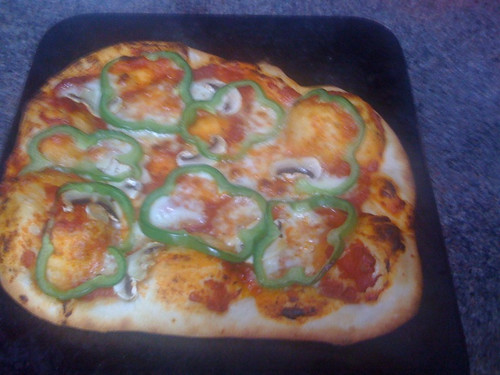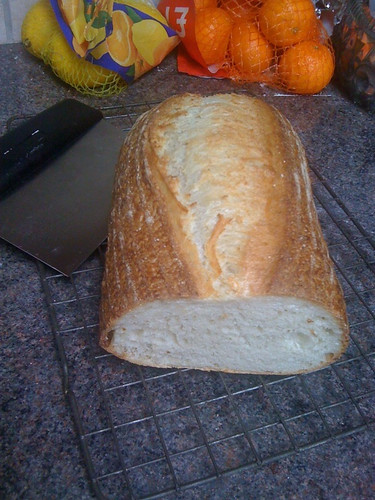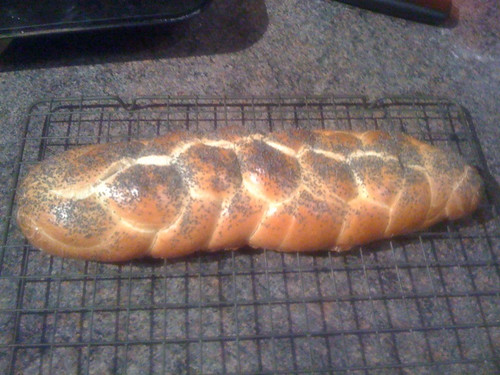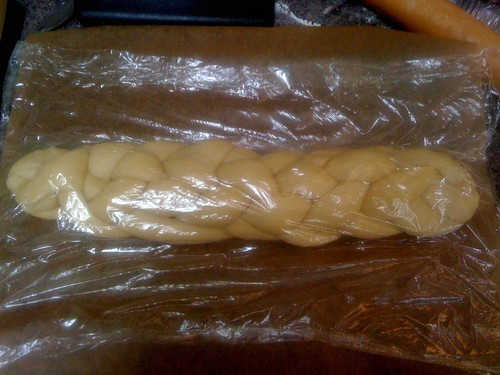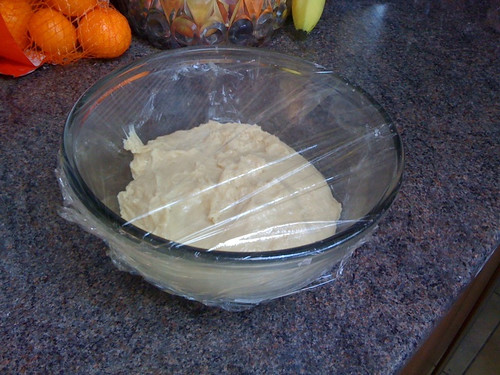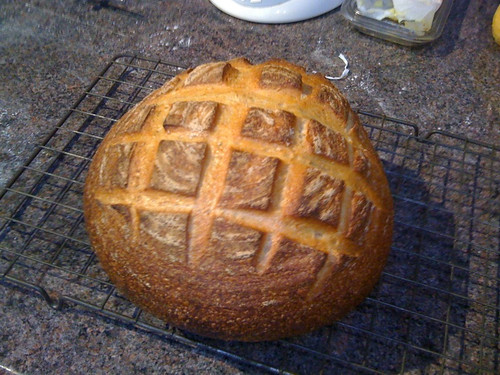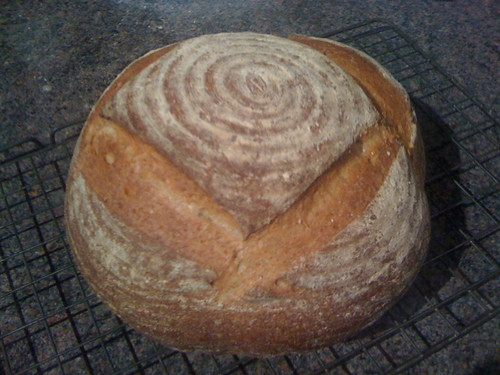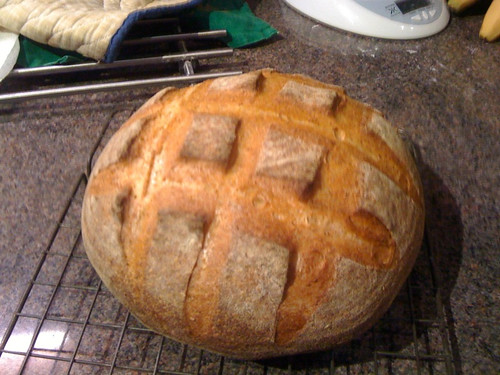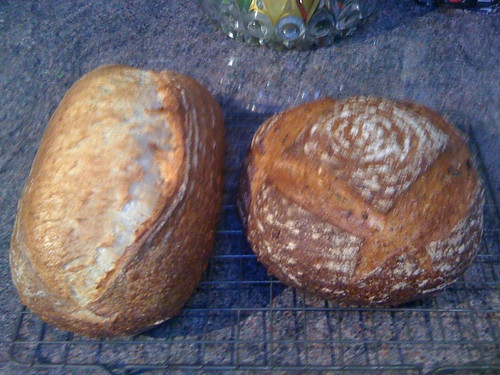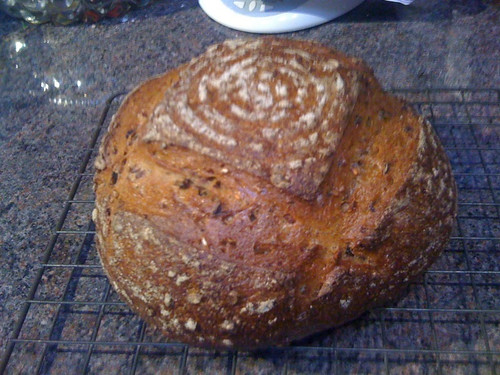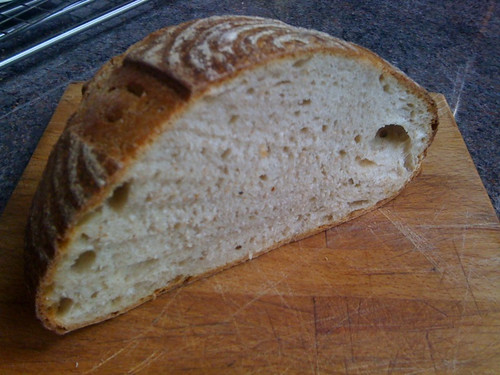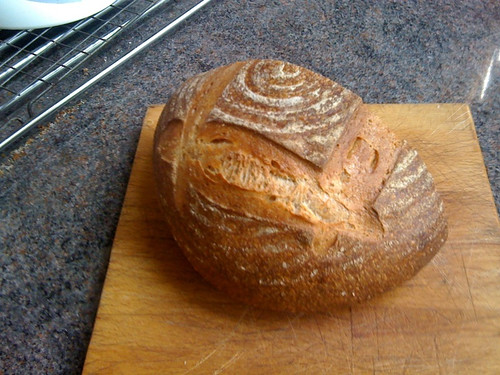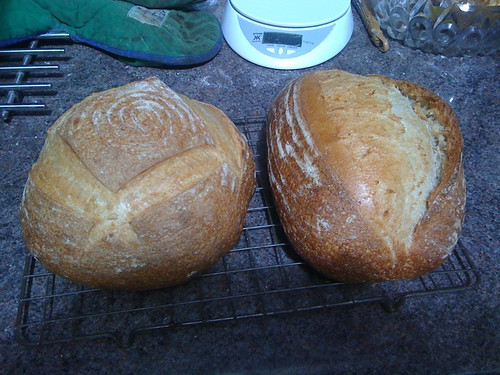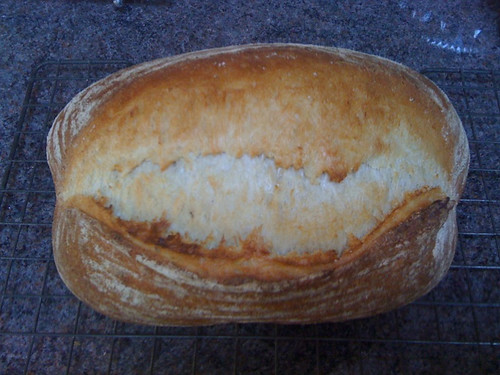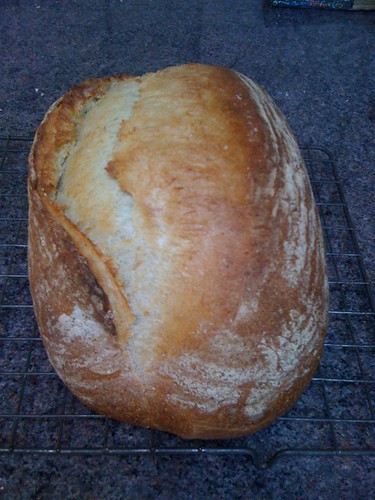Compensating for the crappy challah!
Sunday, 31 July 2011
White sourdough
The uselessness of my challah left me without bread. Whipped this up and let it prove overnight.
Saturday, 30 July 2011
Sourdough Challah -- baked!
Hardest loaf so far. Everything about this loaf was hard, and nothing behaved as the recipe said it would. It said it wouldn't rise during the bulk ferment and it rose like mad. It said the texture would be like modelling clay -- it was more like ointment. Braiding was murder. Then, it said it'd rise three times its size during a five hour prove, and it didn't rise at all!
Next time I try Challah, I'll do a yeasted one rather than a sourdough one.
But at least it's recognizable as challah!
Edit: On cutting, it's gotta be pronounced a failure. Too heavy and doughy. Will try again with yeast next time.
Sourdough Challah - first ferment
Bertinet's method a revelation. I've watched the videos, never really believed it would happen.
Friday, 29 July 2011
Sourdough Challah
Built a biga-life firm sourdough starter tonight, with the aim of baking a couple of sourdough challah's tomorrow.
No question that this will be the most complex bread I've baked yet. Interesting to see how it goes. Gotta wait for my biga to triple in size, which it should have done by midday tomorrow.
Need to buy honey and eggs in the morning, before I bake.
The recipe I'm working from is here:
Sourdough Challah
No question that this will be the most complex bread I've baked yet. Interesting to see how it goes. Gotta wait for my biga to triple in size, which it should have done by midday tomorrow.
Need to buy honey and eggs in the morning, before I bake.
The recipe I'm working from is here:
Sourdough Challah
Thursday, 28 July 2011
Another Place Sourdough
Happy to be back in baking action.
Yesterday's wholewheat and spelt effort was truly delicious. It probably could have used a little more salt -- I was overcompensating for the excess of salt in my previous loaf. At the moment, I'm using Cornish Sea Salt, and measuring by volume. I'm going to have to buy a little drug dealer gram scale so I have something that's accurate to less than a gram. Though my current scale claims it's accurate to the gram, my sense is that it's really only measuring in two gram increments.
This morning, I'm back on my own home-grown recipe -- this time, with the addition of a little rye and wholewheat flour to give the white flour a bit of substance.
Main flour is Sainsbury's own brand Strong Bread Flour. I wanted to see how it performed in comparison to the extra high gluten flour.
Loaf is still cooling. More after I taste it.
Wednesday, 27 July 2011
Wholemeal and spelt sourdough
Sunday morning: I'd had a couple of loaves proving in the fridge overnight, so I got up early to bake. I should have realized something was amiss when a fuse blew, but everything came back on and the oven felt warm, so when the usual hour was up, I put in my pan of boiling water, spritzed in some mist and slapped in my loaf.
When I came to turn it, ten minutes in, I figured out something was wrong. No malliard reaction. The crust was as pale as when I'd put it in. And when I felt the loaf to turn it, the loaf was barely warm.
Turned out that the element on my oven had blown. They should last at least eight years, but this oven was only about four years old. According to the oven repair guy, Smeg had put in a more powerful element than the oven needed. You could see the bulge on the element where one part had distorted and touched another piece of the element.
So, £88 snots to repair that. Next time, I'll just follow these instructions and do it myself.
But I'm glad to be back in baking action.
Been listening to people on Facebook going on about how good spelt flour is. I know it's pretty low gluten stuff, so I didn't want to use it alone. I've seen a few spelt housebricks and they didn't look very appealing.
So I went with a 50% white flour, 25% wholemeal, 25% spelt mix. You can see the picture above. It's still cooling, so I'll let you know how it tastes tomorrow.
Thursday, 21 July 2011
Wholemeal sourdough
Nice wholewheat sourdough tonight. 50% Canadian Extra Strong, 50% Sainsbury's Wholewheat flour.
I'll post a pic of the crumb when I cut it.
Tuesday, 19 July 2011
White sourdough and granary sourdough
Tonight's bake
Baked two loaves tonight -- a white sourdough, and a granary sourdough. Here's a closer shot of the granary:
The granary didn't rise as much as I would have liked, and was a little dense, but the flavour was fantastic. Maybe a small amount of regular yeast along with the sourdough next time? Or possibly just longer proving? It had definitely doubled in size when I put it in the oven, but I didn't get much in the way of oven spring.
That said, I baked this one after I'd baked the white one, so perhaps the oven temp hadn't fully recuperated when I put it in?
Will bake again though.
Monday, 18 July 2011
Wholewheat and Rye Sourdough
Wholewheat and Rye Crumb
Wholewheat and Rye Crust
So here's the loaf that I made last night. A bit of a cross between Norwich Sourdough from the Wild Yeast website, and the Mill Loaf from Dan Leppard's book, The Handmade Loaf.
It's funny, I really like Dan's book -- but I don't really like the look of many of the recipes in it. That said, it was an absolute bargain on Amazon, so I couldn't resist.
Bought another book today. I was wandering around Tesco, buying flour and *spit* yeast, when I saw a copy of the River Cottage Cookbook on Bread. I've been thinking about buying this one from Amazon as well, but when I saw it on offer for nine quid, I couldn't not snap it up.
I'll do some book reviews later -- damn Kindle gave up the ghost today so what else am I gonna do? -- but for now, back to last night's loaf.
Shaping has always been something of a struggle for me. Treat your dough gently, don't manhandle it, and it will repay you with fantastic bread.
Overwork your dough though, and you'll get a tough, nasty loaf that has the texture of old leather and a crust like cardboard.
I've made this loaf before and it didn't work out so well, largely because my oven runs a bit too hot, so the crust was overcooked -- too dark, too tough. But the flavour was good then, so I wanted to see how it would perform now I've got a bit more experience.
Last night, I was making a batard and my pre-shaping went well, but when I came to actually shape the loaf, it ended up too long for the banneton. While it's easy to make a short loaf longer, it's hard to make a long loaf shorter. I took another stab at it, but I ended up with two bulbous ends, and a weak, saggy part in the middle. Any possibility of getting good surface tension on the skin was disappearing rapidly.
So, I decided I'd just let it rest again, and reshape the whole thing as a boule. Which went without a hitch, except for the fact that the boule I put in the banneton was exactly the same size as the dough I'd started bulk fermenting three hours before.
Still, the whole thing doubled nicely within about two hours. Slashed it with a quick Tic-tac-toe pattern, and slammed it on my oven stone.
Fantastic taste and fantastic oven spring, but there are great big air pockets in the final loaf. Not millions, but more than I'd feared. My slashes didn't come out so well either. Not deep enough, perhaps? Or was it the fact that it wasn't exactly in the centre of the oven, so the hotter side got the most rise?
Whatever it was, the final loaf was delicious. Even when you win, you lose.
Saturday, 16 July 2011
Saturday bake
Been baking again today.
Started mixing my leaven at about 5.30:
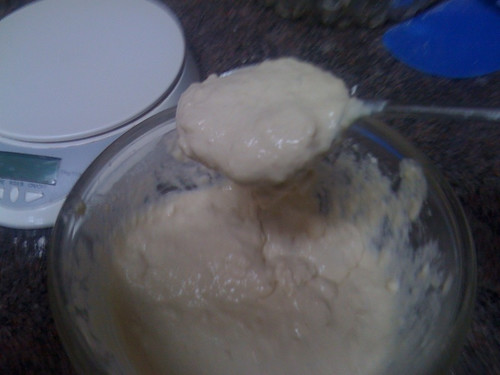
And created my dough at around 11.30, ready for a long overnight prove in the fridge.

Formed my loaves about 9.00am this morning:

And got them into the oven about 1.30 and 2.00 respectively.
They came out looking pretty well. Here's the first -- a boule:
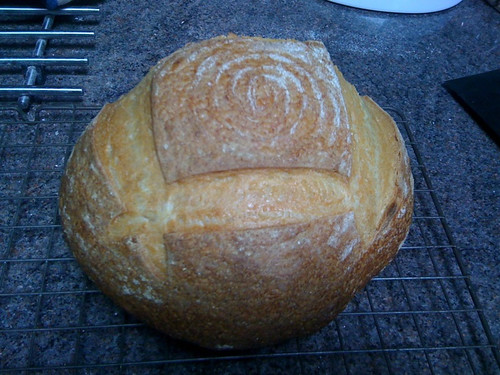
Note the nice blistered crust -- a product of the long, overnight ferment:

Second was a batard, with a most impressive grigne:
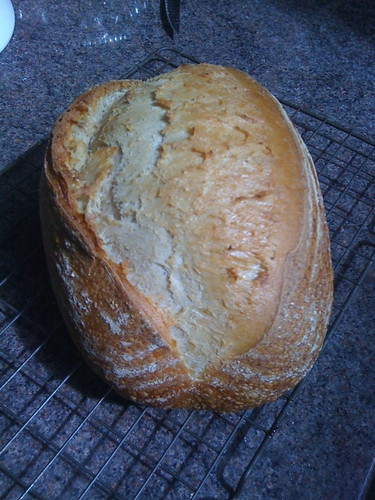
All in all, a good day's work. I suspect the boule might be slightly underdone -- I'm trying to go for a lighter, crispier crust, so I'm turning down the heat to about 210 in my convection oven after 10 - 15 mins or so.
That said, both of them look great, both hit a dough temp of about 99C before I took them out of the oven.
But the proof will be in the eating. I'll upload some pictures of the crust after they've cooled.
Not expecting a very holey crumb with either of these, as the dough was a fairly low hydration effort. Expecting great sour though, because I could smell it as the dough was proofing.
Expect both to be yum!
Thursday, 14 July 2011
Another Place Sourdough
I suppose if I'm going to blog about baking bread, the least I can do is to publish my recipe.
This is my own recipe, really influenced by two other great internet sourdough bakers. Teresa from Northwest Sourdough has a recipe for San Francisco Sour and Susan from Wild Yeast's Norwich Sourdough. Although it's a simple, plain white loaf, what I've really taken from those two loaves is the techniques that they suggest rather than the absolute ingredients, which I worked out for myself using a hydration calculator that I found on Northwest Sourdough.
Given that I live in Crosby, home of Anthony Gormley's Another Place sculpture, I'm calling this recipe Another Place's Sourdough.
Another Place's Sourdough
Ingredients
255 grams white levain (100% hydration)
200 grams water
470 grams flour
9 grams salt
Time
12 hours ripening levain
2.5 - 12 hours bulk fermentation
2 hours - 16 hours proving the loaf
30 - 40 minutes in the oven -- 240C for the first 10 mins, 200C for the last 20-30.
16 -18 hours before you're planning on baking, take 55 grams from your existing levain/sourdough starter. I keep mine in the refrigerator, and feed it every three or four days to ensure I've always got a ripe levain.
To your 55 grams of levain, add 100 grams of room temp. water, and 100 grams of flour. Mix together, and stand overnight. You're looking for a levain that will double in size in about 4 to 6 hours, depending on temperature. The cooler the temp, the longer the doubling will take. The longer you leave the levain before using it, the more flavour you'll get in your loaf.
After about 12 hours, take your levain and add it to a mixing bowl. Add 200 grams of room temperature water to your levain, and mix roughly together.
Weigh out 470 grams of bread flour, sift it, and add it to the levain and water mixture. I begin by adding around 420 grams of the flour as different flours have different absorbancy rates, and then add more and more until the dough seems right. What you're looking for is a dough that is tacky on the outside, but is neither saturated nor overly dry. Ultimately, recognition of what the dough should feel like is something you get with experience, so if you don't know what to look for, just use the exact measurements.
Once the flour, water and levain are mixed together and all the ingredients are incorporated, cover the mixing bowl and allow it to stand for 20 minutes while the dough autolyses. This process makes the dough much easier to knead, and again, makes a better dough.
Next, add your salt. Once the salt is added, it's time to knead. As salt retards the action of your yeast, the dough might be a little tough to work for the first minute or two. If it's too tough, just let it stand for a few more minutes, and then go back to kneading. Your dough should be soft, pliable and easy to knead.
Knead away for about five minutes, until the dough is smooth and pliable and can pass the windowpane test. At this point, oil a mixing bowl or a large tupperware container, using just a few drops on the tips of your fingers. If you're using a mixing bowl, cover the bowl with clingfilm. If a tupperware container, close the container. Allow your dough to stand for 50 minutes.
After 50 mins, gently pat the dough to de-gas it, then stretch your dough into a long rectangle. Fold your rectangle into thirds, then give the dough a quarter turn, and stretch and fold again.
After the stretching and folding is finished, the dough will be tight and hard to work again, so put it back in your container, recover and allow it to stand for another 50 minutes. Then repeat the folding procedure.
What you do next depends on whether you've got time to go ahead and bake in the next three hours, or whether you want to enhance your baking. If you have got time, let it ferment for a final 50 minutes in the container. If you don't have time to bake, you can put it into the fridge for up to sixteen hours. This extended bulk fermentation period will enhance the flavour, but if you have refrigerated the dough, you'll need to give it an hour or two when it comes out of the fridge to get back to room temperature.
Now you're ready to shape the dough. Again, Theresa from Northwest Sourdough has the best videos on YouTube that'll teach you how to shape a boule or a batard. Go and watch one of those.
When your loaf has been shaped, you now want to proof the loaf until it has almost doubled in size. This should take around two hours, but again, it depends on the ambient temperature. As with the bulk fermentation, you can proof two thirds at room temp, and then retard the fermentation either to match your other obligations, or to try and improve the flavour. Cover the loaf with a clean, well-floured cotton tea-towel, pop it into a plastic bag and then put it into the oven.
If you have a baking stone, make sure it's in the oven and pre-heat the oven on its maximum temperature for around 45 mins to an hour.
Five mins before you're ready to bake, put a shallow baking tin on the bottom of the oven containing half a cup of boiling water. The plan here is to try and fill your oven with steam for the first ten mins of the bake. If you have a plant mister, fill it with clean water, and use that to spray down the sides of the oven.
When the temperature is right, pop your loaf, seam side down, onto a peel or oven sheet that has been dusted with corn meal or semolina, or pop it onto a teflon oven mat. (I use the latter.) Slash the top of the loaf with a razor blade, a serrated knife or a lame if you have one, and then pop your loaf on the baking stone.
Keep the oven door closed for the first 5 mins, and then open the oven door and re-mist the oven walls with your mister -- trying to avoid heat escaping. At this point, I also turn the loaf by 180 degrees.
Another 5 minutes at maximum temperature and then I remove the oven tin with the boiling water. Time for steaming is over, it's time to bake.
Turn down the oven to 200C (fan oven) or 210C (ordinary convection oven), give the loaf ten more minutes, and then open the oven door and give the loaf a quarter turn. By now, the loaf has had twenty minutes. In my oven, it usually takes another ten minutes, but I like a lighter, crisper crust. If you prefer a crunchier crust, it may take another twenty minutes.
Test whether the loaf is done either by tapping on the bottom, and listen for a hollow sound. When it sounds hollow, it's done.
Alternatively, you can insert a food thermometer. The inside of your loaf should measure around 99 degrees centegrade (210 fahrenheit). Take the loaf out of the oven, pop it onto a wire rack and leave it to cool for about two hours.
Then cut, butter and eat.
This is my own recipe, really influenced by two other great internet sourdough bakers. Teresa from Northwest Sourdough has a recipe for San Francisco Sour and Susan from Wild Yeast's Norwich Sourdough. Although it's a simple, plain white loaf, what I've really taken from those two loaves is the techniques that they suggest rather than the absolute ingredients, which I worked out for myself using a hydration calculator that I found on Northwest Sourdough.
Given that I live in Crosby, home of Anthony Gormley's Another Place sculpture, I'm calling this recipe Another Place's Sourdough.
Another Place's Sourdough
Ingredients
255 grams white levain (100% hydration)
200 grams water
470 grams flour
9 grams salt
Time
12 hours ripening levain
2.5 - 12 hours bulk fermentation
2 hours - 16 hours proving the loaf
30 - 40 minutes in the oven -- 240C for the first 10 mins, 200C for the last 20-30.
16 -18 hours before you're planning on baking, take 55 grams from your existing levain/sourdough starter. I keep mine in the refrigerator, and feed it every three or four days to ensure I've always got a ripe levain.
To your 55 grams of levain, add 100 grams of room temp. water, and 100 grams of flour. Mix together, and stand overnight. You're looking for a levain that will double in size in about 4 to 6 hours, depending on temperature. The cooler the temp, the longer the doubling will take. The longer you leave the levain before using it, the more flavour you'll get in your loaf.
After about 12 hours, take your levain and add it to a mixing bowl. Add 200 grams of room temperature water to your levain, and mix roughly together.
Weigh out 470 grams of bread flour, sift it, and add it to the levain and water mixture. I begin by adding around 420 grams of the flour as different flours have different absorbancy rates, and then add more and more until the dough seems right. What you're looking for is a dough that is tacky on the outside, but is neither saturated nor overly dry. Ultimately, recognition of what the dough should feel like is something you get with experience, so if you don't know what to look for, just use the exact measurements.
Once the flour, water and levain are mixed together and all the ingredients are incorporated, cover the mixing bowl and allow it to stand for 20 minutes while the dough autolyses. This process makes the dough much easier to knead, and again, makes a better dough.
Next, add your salt. Once the salt is added, it's time to knead. As salt retards the action of your yeast, the dough might be a little tough to work for the first minute or two. If it's too tough, just let it stand for a few more minutes, and then go back to kneading. Your dough should be soft, pliable and easy to knead.
Knead away for about five minutes, until the dough is smooth and pliable and can pass the windowpane test. At this point, oil a mixing bowl or a large tupperware container, using just a few drops on the tips of your fingers. If you're using a mixing bowl, cover the bowl with clingfilm. If a tupperware container, close the container. Allow your dough to stand for 50 minutes.
After 50 mins, gently pat the dough to de-gas it, then stretch your dough into a long rectangle. Fold your rectangle into thirds, then give the dough a quarter turn, and stretch and fold again.
After the stretching and folding is finished, the dough will be tight and hard to work again, so put it back in your container, recover and allow it to stand for another 50 minutes. Then repeat the folding procedure.
What you do next depends on whether you've got time to go ahead and bake in the next three hours, or whether you want to enhance your baking. If you have got time, let it ferment for a final 50 minutes in the container. If you don't have time to bake, you can put it into the fridge for up to sixteen hours. This extended bulk fermentation period will enhance the flavour, but if you have refrigerated the dough, you'll need to give it an hour or two when it comes out of the fridge to get back to room temperature.
Now you're ready to shape the dough. Again, Theresa from Northwest Sourdough has the best videos on YouTube that'll teach you how to shape a boule or a batard. Go and watch one of those.
When your loaf has been shaped, you now want to proof the loaf until it has almost doubled in size. This should take around two hours, but again, it depends on the ambient temperature. As with the bulk fermentation, you can proof two thirds at room temp, and then retard the fermentation either to match your other obligations, or to try and improve the flavour. Cover the loaf with a clean, well-floured cotton tea-towel, pop it into a plastic bag and then put it into the oven.
If you have a baking stone, make sure it's in the oven and pre-heat the oven on its maximum temperature for around 45 mins to an hour.
Five mins before you're ready to bake, put a shallow baking tin on the bottom of the oven containing half a cup of boiling water. The plan here is to try and fill your oven with steam for the first ten mins of the bake. If you have a plant mister, fill it with clean water, and use that to spray down the sides of the oven.
When the temperature is right, pop your loaf, seam side down, onto a peel or oven sheet that has been dusted with corn meal or semolina, or pop it onto a teflon oven mat. (I use the latter.) Slash the top of the loaf with a razor blade, a serrated knife or a lame if you have one, and then pop your loaf on the baking stone.
Keep the oven door closed for the first 5 mins, and then open the oven door and re-mist the oven walls with your mister -- trying to avoid heat escaping. At this point, I also turn the loaf by 180 degrees.
Another 5 minutes at maximum temperature and then I remove the oven tin with the boiling water. Time for steaming is over, it's time to bake.
Turn down the oven to 200C (fan oven) or 210C (ordinary convection oven), give the loaf ten more minutes, and then open the oven door and give the loaf a quarter turn. By now, the loaf has had twenty minutes. In my oven, it usually takes another ten minutes, but I like a lighter, crisper crust. If you prefer a crunchier crust, it may take another twenty minutes.
Test whether the loaf is done either by tapping on the bottom, and listen for a hollow sound. When it sounds hollow, it's done.
Alternatively, you can insert a food thermometer. The inside of your loaf should measure around 99 degrees centegrade (210 fahrenheit). Take the loaf out of the oven, pop it onto a wire rack and leave it to cool for about two hours.
Then cut, butter and eat.
Sourdough #27
So my bannetons arrived this morning...
If I'd known that I was going to get as obsessed with baking bread when I first started, I'd have been more scrupulous about recording and documenting what I was doing. As it was, I just kind of fell into it.I've been somewhat interested in sourdough for a couple of years now. By which I mean I'd read the FAQ, and toyed with the idea of baking it, but I never really did anything about it.
Then two things happened. Nigel Brunton posted on Facebook about how he had a sourdough loaf about to go into the oven -- and so I had a conversation with Nigel about how I've been thinking about doing it. And secondly, my wife Gerry got a starter going and baked her first loaf.
That loaf came out well. By which I mean that it rose well, and the crust and crumb were both acceptable. But it didn't really taste like sourdough.
And the more I read about it, the more it seemed it didn't look or taste like sourdough either.
Like many men, I'm obnoxious in my treatment of women. If a woman does X, I'm inclined towards saying, 'Well yeah, that's kind of OK but you should have done X, Y and Z. Then it would have been *really* good.'
Like most men, mostly I'll just gripe and moan and issue instructions as to how to improve something. But every now and again, I'm inclined to *show* them how it's supposed to be done if you're going to do the thing properly.
Somehow, sourdough baking fell into this last category.
When it came to baking the second loaf, I'd read a pile of introductory recipes on the net. And the second loaf was definitely an improvement on the first. But the more I read, the more I knew, the more dissatisfied I was with my loaf. I could see that it wasn't enough to just bake the damn thing. You needed paraphernalia to do this thing properly. And if there's one thing that a man likes, it's paraphernalia. Or as we normally refer to them -- toys.
Over the past few weeks, I've spent a pile of money on all manner of baking stuff. A cast iron casserole dish for making No Knead bread (a disappointing failure.) A granite counter-top protector to use as an oven stone and the old wood and coal fire oven (a great success -- that produced the 'oven spring' my bread had been lacking up until that point.)
As I said, I've had the crust and crumb sorted out for some time now. What my loaves were really lacking was aesthetic appeal. I was forming batards by hand, and doing my second prove in an old floured tea-towel. The taste was usually fine, but they tended to look awful. A peculiar shapeless mass.
And the other thing that I didn't seem able to master was the 'grigne' -- that wonderful effect that happens when you slash a loaf and the loaf rises in a controlled manner to form that striated effect, along with the bit that the French refer to as 'the ear' -- that flap of dough at the slash that tends to become the darkest part of the loaf.
Slashing is a crucial part of artisan bread, not only because the controlled bloom looks so great, but it's a critical part of how you shape a loaf.
Unfortunately, because of the high hydration levels of the dough I've been mixing, my attempts to slash the loaf tended to drag and make an unsightly edge, and allows all of the air to go out of the dough, leaving me with a floppy mess. I had been thinking that in order to get the kind of slashes that I wanted, I'd need to buy an expensive lame -- Mure and Peyrot do a lovely plastic razor blade holder for a tenner -- how could I possibly go wrong with such a thing?
But I've been experimenting with longer proving times -- refrigerating the dough overnight during bulk fermentation, and refrigerating the formed loaf for a few hours in order to improve flavour. I noticed that if I used a serrated knife on a loaf after it had come out of the fridge, I was able to slash it in exactly the ways I'd been trying and failing at when the dough was at higher temperatures.
And if I underproved the dough slightly before putting it in the fridge for the second retarded prove, I also got a much improved oven spring. These two factors, when combined together, got me far closer to my goal of making the perfect artisan loaf.
But the thing that seems to have made the most difference was the purchase of my bannetons. Every time I read a recipe, or watch a little breadmaking clip on YouTube, the baker always has a banneton or a brotform that they use to shape their loaves. I couldn't help but think that they were contributing more than just that pretty spiral pattern on the loaf. And bakers are notoriously stingy. It's hard to imagine that they'd be spending twelve quid on a proving basket if it didn't have a significant impact in some way.
Well, you can judge for yourself. But I'm really impressed. My loaves appear to have made a step up to the next level.
Twelve quid well spent.
Subscribe to:
Posts (Atom)
